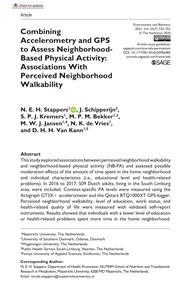This study explored associations between perceived neighborhood walkability and neighborhood-based physical activity (NB-PA) and assessed possible moderation effects of the amount of time spent in the home neighborhood and individual characteristics (i.e., educational level and health-related problems). In 2016 to 2017, 509 Dutch adults, living in the South Limburg area, were included. Context-specific PA levels were measured using the Actigraph GT3X+ accelerometer and the Qstarz BTQ1000XT GPS-logger. Perceived neighborhood walkability, level of education, work status, and health-related quality of life were measured with validated self-report instruments. Results showed that individuals with a lower level of education or health-related problems spent more time in the home neighborhood. The perceived neighborhood walkability only affected NB-PA for individuals spending a relatively large amount of time in their home neighborhood. PA-facilitating features in the home neighborhood, for example, aesthetics, were only associated with more NB-PA for individuals without health-related problems or with a higher level of education.
DOCUMENT

Neighborhood image processing operations on Field Programmable Gate Array (FPGA) are considered as memory intensive operations. A large memory bandwidth is required to transfer the required pixel data from external memory to the processing unit. On-chip image buffers are employed to reduce this data transfer rate. Conventional image buffers, implemented either by using FPGA logic resources or embedded memories are resource inefficient. They exhaust the limited FPGA resources quickly. Consequently, hardware implementation of neighborhood operations becomes expensive, and integrating them in resource constrained devices becomes unfeasible. This paper presents a resource efficient FPGA based on-chip buffer architecture. The proposed architecture utilizes full capacity of a single Xilinx BlockRAM (BRAM36 primitive) for storing multiple rows of input image. To get multiple pixels/clock in a user defined scan order, an efficient duty-cycle based memory accessing technique is coupled with a customized addressing circuitry. This accessing technique exploits switching capabilities of BRAM to read 4 pixels in a single clock cycle without degrading system frequency. The addressing circuitry provides multiple pixels/clock in any user defined scan order to implement a wide range of neighborhood operations. With the saving of 83% BRAM resources, the buffer architecture operates at 278 MHz on Xilinx Artix-7 FPGA with an efficiency of 1.3 clock/pixel. It is thus capable to fulfill real time image processing requirements for HD image resolution (1080 × 1920) @103 fcps.
DOCUMENT

Introduction In 2016 a new form of integrated community treatment for patients with serious mental illnesses was implemented in two neighborhoods in the city of Utrecht (335000 inhabitants) in the Netherlands. Treatment is characterized by close collaboration of psychiatric care, somatic care (i.e. general practitioner, nurse practitioner), supported housing and other facilities, i.e. the police officer, and is provided in the direct neighborhood of the patients. This ‘neighborhood based integrated mental health care’ should not contribute solely to clinical recovery, but also specifically to social and personal recovery. Objectives The aim of this research was to investigate the experience of patients with serious mental illnesses themselves receiving this new form of neighborhood-based integrated mental health care. More specific the question is studied if and how neighborhood-based integrated mental health care supports personal and social recovery. Methods To assess the experience of patients in depth qualitative semi-structured interviews were conducted with 20 patients. Patients were asked to participate in interviews directly by the researchers, by their case managers and by experts by experience. Interview topics included personal and social recovery, resilience and self-efficacy related to the collective effort of caregivers. Qualitative data was analyzed by three independent researches with the qualitative computer program Tarzan. Strategies to enhance quality of data analysis (respondent validation) and validity (attention to negative cases) were used. Results The study will be finished in January 2019. Conclusions The results, a brief description of the collaborative care methodology offered and experiences of patients, and conclusions will be presented at the ENMESH conference.
DOCUMENT

Due to societal developments, like the introduction of the ‘civil society’, policy stimulating longer living at home and the separation of housing and care, the housing situation of older citizens is a relevant and pressing issue for housing-, governance- and care organizations. The current situation of living with care already benefits from technological advancement. The wide application of technology especially in care homes brings the emergence of a new source of information that becomes invaluable in order to understand how the smart urban environment affects the health of older people. The goal of this proposal is to develop an approach for designing smart neighborhoods, in order to assist and engage older adults living there. This approach will be applied to a neighborhood in Aalst-Waalre which will be developed into a living lab. The research will involve: (1) Insight into social-spatial factors underlying a smart neighborhood; (2) Identifying governance and organizational context; (3) Identifying needs and preferences of the (future) inhabitant; (4) Matching needs & preferences to potential socio-techno-spatial solutions. A mixed methods approach fusing quantitative and qualitative methods towards understanding the impacts of smart environment will be investigated. After 12 months, employing several concepts of urban computing, such as pattern recognition and predictive modelling , using the focus groups from the different organizations as well as primary end-users, and exploring how physiological data can be embedded in data-driven strategies for the enhancement of active ageing in this neighborhood will result in design solutions and strategies for a more care-friendly neighborhood.